Orient the buildings with longer axes in the east-west direction. Use north-facing high thermal mass living areas with passive solar.

Design Of A Sustainable Residence In Composite Climate Of India
CLIMATIC CONSIDERATIONS PROJECTIONS.

. The 40 of household energy used for heating and cooling to achieve thermal comfort could be cut to almost zero in new housing through sound climate responsive design. CLIMATIC CONSIDERATIONS JALIS. Concrete brick tile and thick plaster will absorb large quantities of heat and release it slowly.
The composite climate is neither constantly hot and dry nor warm and sticky. The Design of Buildings for Comfort in the Nigerian Climate. Up to 24 cash back This rate could be cut to almost zero in new housing through sound climate responsive design and indeed should be our aspirational goal.
The flat roof is a good reflector and re-radiates heat efficiently especially if it consists of a solid white painted material. Jalis on the outer facade of the building helps in cooling shading and ventialtion. There are certain design considerations for composite region buildings which should resist heat gain in summer and resist heat loss in winter.
With reference to the same the prompted design considerations vary. With reference to the same the prompted design considerations vary. Warm and humid 3.
Passive solar systems basic rules-1. The size of the windows on the east and west sides should be minimized in order to reduce heat gain. Designing for climate research paper 1.
DESIGNING FOR CLIMATE Residential Design in the Tropics. This climatic zone is not normal as seen in hot and dry or any other climatic zones. Effective Design Considerations for Composite Climate Nature of the Composite Climate.
Composite pavement designs Rehabilitation and overlays Evaluates effects of specification changes MEPDG. Design for climate means that a home is designed or modified to. Design the devices to perform more than one function.
Design living spaces to face cooler facades. And the sky conditions are againvariable which because it experiences all the 3 seasons. An architects aim would be to.
Passive design strategies in composite warm-humid climates. Warm and humid 3. Composite region Characteristics of the composite.
This helps in receiving less radiations which results in lesser heat gain reduces the overall air conditioning requirement thus saves energy Proper orientation also helps in receiving natural light ventilation. Architectural considerations for composite climate introduction. So composite climate receives3 distinct seasons summers monsoons and winters and the conditions vary in each ofthese seasons which is what the problematic causes.
The buildings south face should receive sunlight between the hours of 900 AM. REQUIREMENTS IN A HOT AND HUMID CLIMATE Minimization of the high day temp. For a half year it could display the following weather conditions.
CLIMATE RESPONSIVE DESIGN STRATEGIES IN COMPOSITE CLIMATE In passive solar energy mechanical means are not employed to utilize solar energy. Hot-dry early summer warm-humid late summer monsoon period and cold-dry period in winter. This paper focuses on various bioclimatic design strategies Orientation of building plays a vital role in achieving energy for building design in a composite climate like Delhi.
Orient the house with the long axis east-west to minimize exposure to rising and setting sunlight. Climate responsive architecture takes into consideration seasonality the direction of the sun sun path and solar position natural shade provided by the surrounding topography environmental factors such as wind rainfall humidity and climate data temperature historical weather patterns etc to design comfortable and energy-efficient homes. The Composite Climate was chosen to study due to its annual.
IMPACT OF CLIMATE ON DESIGN OF RURAL DWELLINGS IN COMPOSITE CLIMATE WARM HUMID TYPE CLIMATE. Geography of Nigeria Retrieved from http. Design considerations Choose a site exposed to cooling breezes and design to exclude adverse winds while allowing for cross-ventilation and night purging.
Place patios and decks on the north side in the shade of the building. In the creative process of building design a great deal of consideration is given to the physical landscape of a development. An adaptive thermal comfort design is essential.
Reduction in the humidity levels Continuous air circulation to reduce heat and relief from stickiness. DESIGNING FOR CLIMATE Residential Design in the Tropics Martin Clark BA GradDipTP Original Edition 12101993 Revised 26092006 The original of this document was prepared as lecture notes for the Bachelor of Construction Management course. Architecture in Composite Climate.
ORIENTATION OF BUILDING In composite climate the orientation of the buildings is preferable in North-East South-West Directions. Passive solar systems basic rules-1. Passive strategies provide thermal and visual comfort by using natural energy sources sinks.
Now the physiological objectivefor composite climate becomes very difficult. The building should be elongated on an east-west axis. Double walls with insulation in between are a suitable solution.
Journal of the Nigerian Institute of Architects vol 4 No 5. Often referred to as climatology it is to study the various climate-based influencing factors on our living conditions particularly under the heads of seasonality sunlight rain wind and humidity of the target construction site for maximal dialogue between the structure and its surroundings in particular the climate. Solar radiation outside air wet surfaces vegetation etc means in composite climate.
The place experiences three definite seasons. Avoidance of direct exposure of facades to solar radiations. The actual comfort conditions achieved will be contextual and depend on the building topology and building design specifications.
The passive design strategies for composite climate and also presents the various methods of passive cooling techniques. The objectives set for composite climate apply to the objectives. Orientation of the future buildings footprint entrances exits glazing interior spaces etc are prudently arranged and manipulated to create the most aesthetically pleasing efficient and economical plan for the.
Composite region Characteristics of the composite region are very hot and dry summer followed by a humid season with monsoon rains. The composite climate zone covers the central part of india. This communication presents design considerations and thermal performance of a hostel building using passive techniques for a composite climatic condition of Delhi India.
Large projecting eaves and wide verandahs are needed in composite climate as out-door living areas to reduce sky glare keep out the rain and provide shades. Incorporation of solar passive techniques in a building design helps to minimize load on conventional systems such as heating cooling ventilation light. And 300 PM during the.
Use minimal heating or cooling. PASSIVE SOLAR DESIGN FOR MUD HUTS IN JHARKHAND CONSIDERING MICROCLIMATIC PARAMETERS FOR COMFORT JANMEJOY GUPTA. The key of design take an advantage of local climate microclimate for human comfort.
Hot and dry 2.

Passive Design Techniques Passive Design Design Skylight Architecture
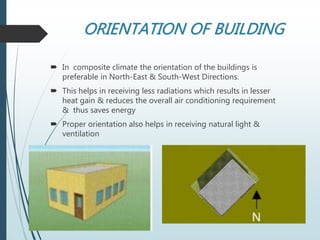
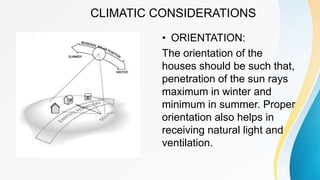
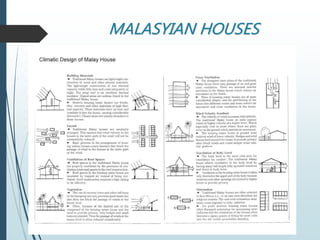
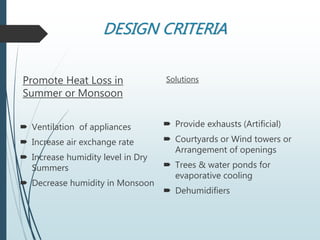

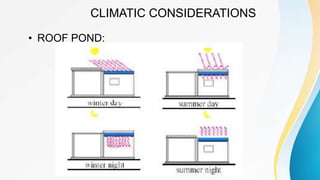
0 comments
Post a Comment